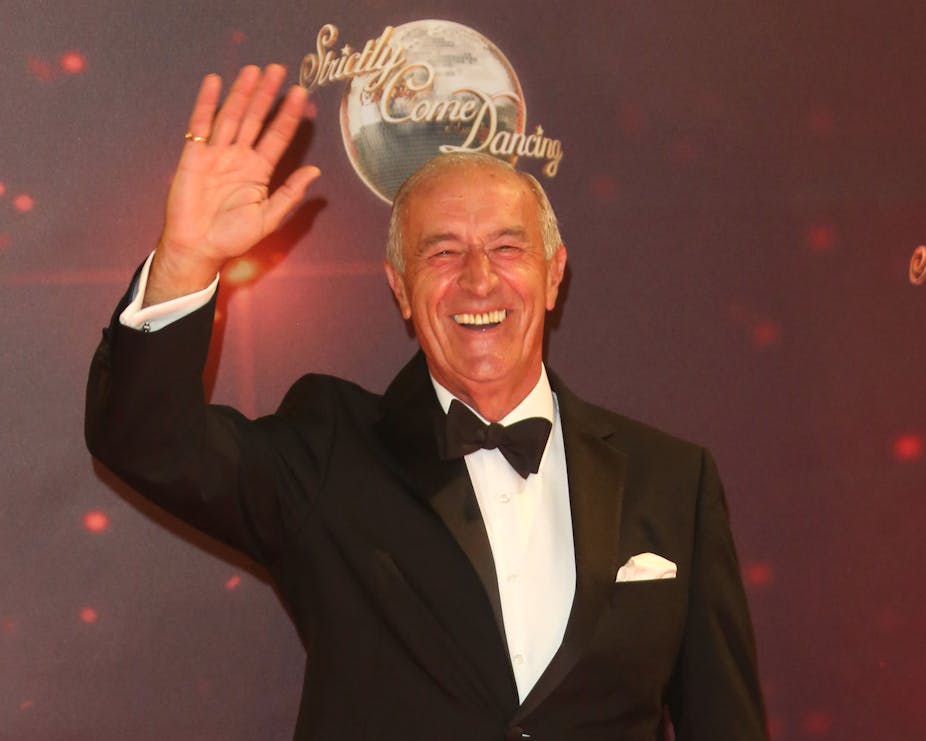With the news of Len Goodman’s death at age 78, ballroom dancing has lost one of its greatest advocates. But Goodman has left a lasting legacy, spearheading an unlikely revival of the ballroom scene he loved.
As head judge on Strictly Come Dancing from 2004 to 2016, Goodman brought a no nonsense honesty to his role, as well as his wealth of expertise. The sparkle, camp and glam of the days of the BBC’s original dance show, Come Dancing, was rekindled in his cheeky quips and cheesy one liners – part of its familiar, broad appeal.
For children of the 1970s like me, early memories of ballroom dancing probably came from late night screenings of Come Dancing, the amateur dance contest that inspired Strictly.
In the days before 24-hour broadcasting, in the hazy excitement of staying up later than I should have, I can recall flicking through the channels (all three of them) and stumbling across the curious world of the ballroom.
Almost voyeur-like, I’d entered a world seemingly preserved in aspic – another 1970s favourite. Sequins, frills, shiny hair, patent leather, an overabundance of makeup, tight trousers and a lot of “cha cha chaa”. All fronted by Angela Rippon, whose restrained received pronunciation seemed at odds with this brashness.
What I didn’t realise at the time, was that I was observing a cultural pursuit that was at a nadir in terms of both its popularity and public perception. Although Come Dancing was to stumble on for another decade or so, ballroom dancing looked like it was finished.
Read more: How Strictly is challenging the way people think about dance
Sure, it had thousands of devotees who competed regularly in town halls and the ever-shrinking number of ballrooms dotted around the country, but its golden age seemed to have gone forever. And boy had ballroom had a golden age!
How ballroom shaped Britain
Ballroom dancing was one of the most important social and cultural features of 20th century Britain. While a distinction was to grow between “ballroom dancing” of the type featured on Come Dancing (competitive, semi-professional) and the “social dancing” enjoyed by millions in the dance halls of the country, they both drew from the same cultural roots.
First codified by dance teachers in Britain in the 1920s, the foxtrot, waltz, quickstep and others were later joined by the jive and the twist. In between, fashionable interlopers such as the Charleston, the Big Apple and the jitterbug briefly pushed their way onto the dance floor.

A vast industry grew up to cater for the demand of Britons to dance, as chains of dance halls sprang up in every town and city in the land. Led by groups such as Mecca (latterly of bingo fame), they were catering for the needs of a working- and lower middle-class population with more time and money than ever before and in need of letting their hair down.
In 1950, the Daily Mirror estimated that over 70% of people met their future husbands or wives while dancing – my own parents among them. Romantic music, close embraces and dim lighting made the ballroom the place to meet.
By 1959, 5 million people went dancing every week, in over 3,000 venues. But it was more than just dancing they offered. They served a variety of important social functions.
For women, as my mother attested, dancing was particularly important. Offering a form of peer group independence, it was an important form of exercise, allowed interaction with boys from an early age and entry into the “public sphere”. All that in a venue that was safe and where they were usually better skilled than their male counterparts.
Learning to dance was a key part of the younger generation’s transition to adulthood and the dance hall offered them a place to experiment with their appearance, identity and friendships.
As Britain grew more racially diverse – particularly from the 1950s onwards – the dance hall was one of the first and most important venues where people of different races came into close contact with one another, with their shared love of dancing.
From the 1920s to the mid 1960s, dancing was central to the nation’s social and cultural history – Britons were dancing mad.
Len Goodman’s influence
Len Goodman was one such dance-mad Brit. Born working class in Bethnal Green, London in 1944, he came to dancing relatively late at 19. He soon made up for this though and by his twenties he was winning dancing competitions up and down the country.
He went on to have a stellar competitive dancing career. For most of us though, it took the arrival of the BBC’s Strictly Come Dancing in 2004 for Goodman to come to our attention. Adding a touch of irony to the highly codified world of ballroom, the programme has revitalised interest in this kind of dancing.
With its combination of high camp, competitiveness, sexy professionals, hapless celebs, pantomime goodie and baddie judges and good old fashioned music and dance spun for the contemporary audience, it has been a remarkable hit. At its height it has attracted audiences of over 11 million. Moreover, it has driven a revival of interest in ballroom dancing that rescued it from oblivion.
Goodman made several television programmes on the history of dancing and published several books on the topic – all reflective of the newfound interest in ballroom.
Perhaps the best way to honour Goodman’s memory would be to reopen dance hall venues across the country, complete with live music, mirror balls and sprung dance floors. In an increasingly isolated society, the revival of such a rich social world would certainly get a “ten from Len” (and from me).

